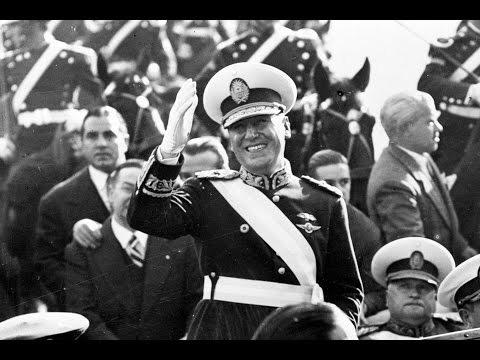 |
| Juan Domingo Perón |
Subject of what many consider the most powerful political mythology in the modern history of Argentina—that of Peronismo (Peronism)—Juan Domingo Perón remains, despite his eminently public life, a deeply enigmatic figure—at once a populist, a man of the people, a friend of the working class, a dictator, a demagogue, an enemy and ally of the military, and the politician most responsible for a host of failed government policies that nonetheless continue to resonate among large segments of the populace.
For three decades—from his burst onto the political stage in 1944–45 until his death in office in 1974—Perón dominated the Argentine political landscape, while his ambiguous and divisive legacy endured long after his death. Understanding modern Argentine history requires understanding the complex political legacy he bequeathed.
Born on October 8, 1895, in a small town near Lobos in the province of Buenos Aires to a farming family, by some accounts out of wedlock, Perón entered the military at age 16 and rose gradually in rank.
 |
In 1929 he married Aurelia Tizón, who died nine years later of uterine cancer. In 1938, the year of his wife’s death, he traveled widely in Europe, where he came to admire the regime of Italian fascist dictator Benito Mussolini.
In 1943 he participated in a coup against the conservative regime of Ramón Castillo, and soon after became head of the Department of Labor—one of the weakest government ministries—which he used as a platform to build his own power base, forging alliances with segments of Buenos Aires’s powerful labor unions.
Named vice president and secretary of war, on October 9, 1945, he was ousted and jailed by enemies in the military. There followed one of the defining events of modern Argentine history, when mass demonstrations by los descamisados (the shirtless ones) forced his release on October 17.
Four days later he married the actress Eva (Evita) Duarte. Until her death, also from uterine cancer, in July 1952 at age 33, Evita was wildly popular among working people and coequal in creating and popularizing the Perón mythology.
Building on his strong political momentum, Perón was elected president in February 1946. During his first term (1946–52), at the height of his political power, he implemented a host of populist policies intended to solidify his support among the country’s powerful labor unions, proclaiming his populist vision a "third position" between capitalism and communism.
His policies sparked rising government debt and growing economic crisis while polarizing Argentine society into Peronist and anti-Peronist factions. Reelected in 1951, he was ousted in September 1955 in a military coup. For the next 18 years he lived in exile, mainly in Spain, in 1961 marrying nightclub singer María Estela Martínez, or Isabel Perón.
Following years of military dictatorship marked by growing social discord and political polarization, he returned to Argentina in 1973 and won his third term as president. He died in office on July 1, 1974, his wife and vice president, Isabel, succeeding him until her ouster by a military coup in March 1976.
EmoticonEmoticon